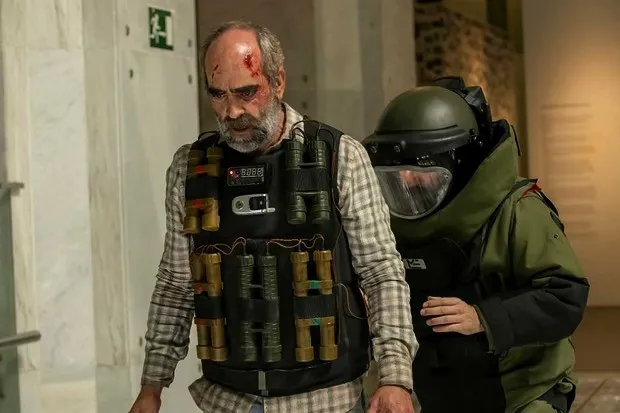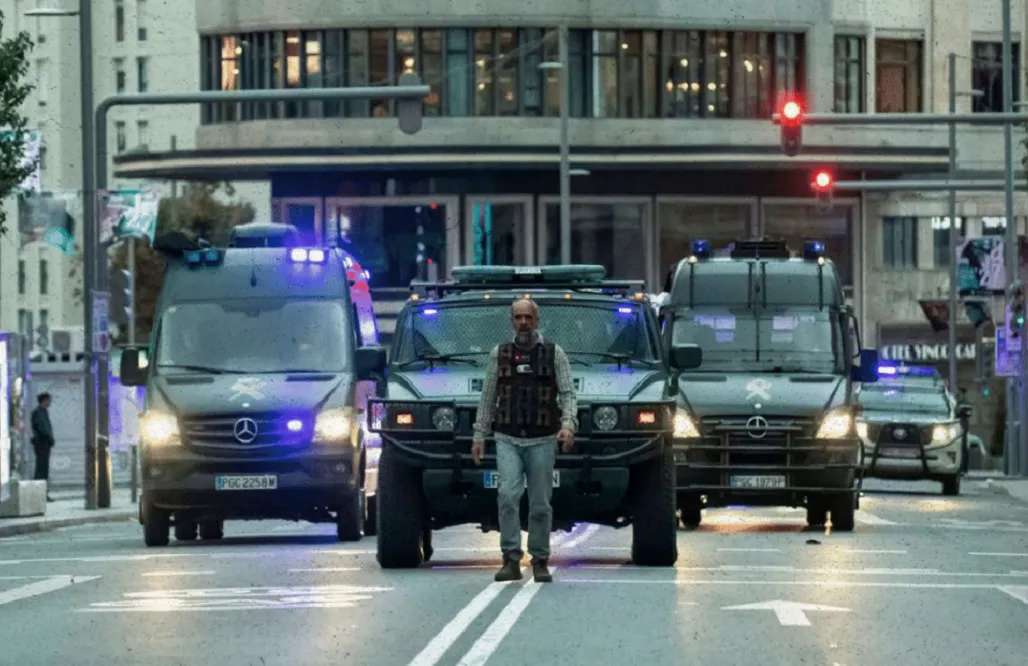The Threat: A Gripping Spanish Thriller Exploring the Complexities of Terrorism
Santini (Luis Tosar), a middle-aged taxi driver in Madrid, unwittingly picks up an injured man (Nourdin Batan) in the aftermath of an airport bombing. To his horror, he discovers that his passenger is one of the terrorists, who then takes Santini hostage. Desperate to evade capture, the terrorist sees the unassuming driver as a valuable asset in outmaneuvering the police.

Luis Tosar as Santini in a scene from “The Threat”
Terrorism has been a persistent global issue for decades, inspiring countless filmmakers to explore its multifaceted nature through various genres. While many films use terrorism as a mere plot device for villains to execute their schemes, “All the Names of God” (released internationally as “The Threat”) stands apart as a thought-provoking Spanish thriller that delves into the social implications of terrorism.
A Director’s Exploration of Terrorism Beyond Action
Daniel Calparsoro, a Spanish director known for his crime dramas and thrillers since the mid-1990s, has previously touched upon terrorism in films like “Blindly” and “Invader.” However, these earlier works primarily used terrorist acts as a backdrop for action-packed sequences. In “The Threat,” Calparsoro ventures deeper, attempting to understand the motivations of the perpetrators and the far-reaching impact of terrorist acts on the lives of both the perpetrators’ families and their victims.

Inma Cuesta as Pilar in a scene from “The Threat”
An Ordinary Man Caught in Extraordinary Circumstances
Santini embodies the everyday Spaniard, a devoted husband and father whose world revolves around his family. Through Santini’s accidental entanglement with the surviving terrorist, Hamza, the director illustrates how anyone, regardless of their political involvement, can become a victim of terrorism. The film highlights how terrorists view ordinary citizens as mere collateral damage, with the primary goal being to instill fear and paranoia within the public. This fear leads to suspicion of outsiders and the immediate labeling of anyone deemed “suspicious” as a potential threat.
Echoes of “Speed” with a Deeper Meaning
“The Threat” shares some thematic similarities with the classic action thriller “Speed,” as Santini is unwillingly thrust into the terrorists’ plans. He is forced to wear a vest rigged with explosives that will detonate if he stops moving. The terrorist leader monitors his movements through live television broadcasts, ready to trigger the device remotely at any moment.
While the parallels to “Speed” are undeniable, they don’t detract from the film’s impact. Calparsoro’s film, with its original title referencing the 99 names of Allah, explores the duality of Hamza’s character. He is both a criminal and a victim, manipulated by shadowy figures seeking to exploit his vulnerabilities. Initially, Hamza appears as a ruthless kidnapper, but as the story unfolds, we see glimpses of his inner conflict. Perhaps it is the deeply ingrained religious teachings from his mother that prevent him from killing Santini, even when provoked.
Faith, Manipulation, and the True Meaning of Islam
In a poignant conversation with Santini, Hamza reveals that his handler promised him visions of paradise upon sacrificing his life for Allah. However, in his moment of truth, he recalled his mother’s teachings about the names of God: Merciful, Holy, Pure, Protector, Guardian. These names stand in stark contrast to the violence he is about to commit. During a police interrogation, Hamza’s mother vehemently asserts that a true Muslim cannot be a terrorist and that her son has been manipulated by those who twist the teachings of the Quran for their own selfish purposes.

Luis Tosar as Santini in a scene from “The Threat”
A Nuanced Perspective on Islamic Terrorism
“The Threat” navigates the complex issue of Islamic terrorism with sensitivity, avoiding the dangerous generalization of equating all Muslims with terrorists. Calparsoro presents Hamza as a conflicted individual, torn between his childhood faith and the indoctrinated ideology of violence.
The director draws a parallel between the tragedies experienced by the families of victims and the families of terrorists. While Santini’s wife and son receive widespread sympathy, Hamza’s relatives face harassment and judgment. Calparsoro suggests that terrorism inflicts pain on all involved, regardless of their connection to the act. This humanist message is powerfully conveyed in a scene where Santini delivers Hamza’s prayer beads to his mother, fulfilling his final request.
Strong Performances Elevate the Narrative
While the film could benefit from more individualized portrayals of law enforcement officers, Pilar, a determined member of the anti-terrorism unit, stands out. Played by Inma Cuesta, Pilar is a staunch opponent of sacrificing Santini, recognizing him as a human being with a family and a future.
However, the standout performances belong to Luis Tosar and Nourdin Batan, who bring depth and nuance to their roles as Santini and Hamza. The two characters, seemingly worlds apart, are both victims in their own right. Hamza is a victim of extremist propaganda, while Santini is a hostage forced to participate in a terrorist plot. The film offers no easy solutions to the problem of terrorism, leaving the ending open to interpretation. However, its call for understanding and its refusal to demonize all Muslims sets it apart from many simplistic action films on the subject.